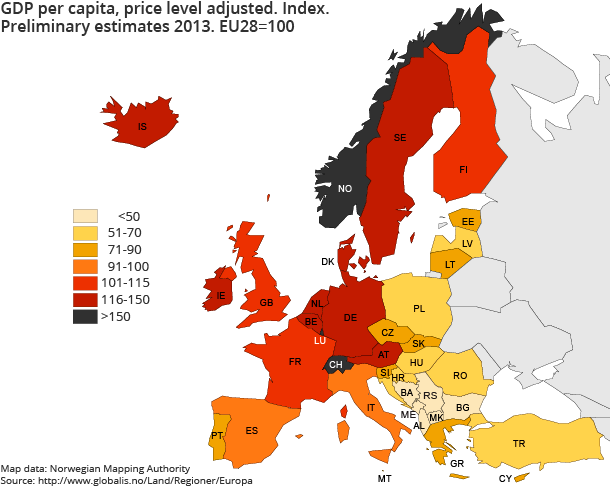Content
Published:
This is an archived release.
Large variations in Europe
Newly released figures from Eurostat show that the price level-adjusted gross domestic product (GDP) per capita of Luxembourg was nine times higher than that of Bosnia-Herzegovina in 2013. Norway had the second highest price level-adjusted GDP per capita in Europe.
| 2013 | |
|---|---|
| 1Source: Eurostat | |
| Norway | 191 |
| Iceland | 116 |
| Sweden | 127 |
| Denmark | 125 |
| Finland | 112 |
| France | 108 |
| Italy | 98 |
| Poland | 68 |
| Spain | 95 |
| United Kingdom | 106 |
| Germany | 124 |

According to Eurostat, the Western Balkan countries (Bosnia and Herzegovina, Albania, Macedonia, Serbia and Montenegro) stand out as having Europe’s lowest price level adjusted-GDP per capita, while Luxembourg comes out on top. One particular feature of Luxembourg’s economy, which could explain its very high GDP per capita, is that a high proportion of the country's employees live in neighbouring countries and therefore contribute to GDP, but are not included in the resident population.
The Norwegian GDP per capita (price level-adjusted) was the second highest in Europe; 91 per cent above the average of the 28 EU countries (EU28=100) in 2013. Switzerland succeeded Norway in the comparison, with a GDP per capita that is 58 per cent above the EU average. Austria, Sweden, the Netherlands, Ireland, Denmark and Germany followed, all with a GDP per capita between 24 and 29 per cent above the EU28 average.
Gross domestic product (GDP) per capita is often used as an estimate of the prosperity of a country. The results in this article show GDP per capita converted by purchasing power parities (price level-adjusted GDP per capita). This ensures that differences in price levels across countries are taken into account. These preliminary results are based on the latest GDP data for 2013 and the most recent PPPs available. Revised estimates will be published in December 2013.
From EU27 to EU28Open and readClose
The level per country is expressed related to an average consisting of today’s 28 EU countries (EU28=100), after Croatia became a member state on 1 July 2013. This implies that the indices in this article are not directly comparable with indices in earlier publications. Nevertheless, all figures in Statbank and in the tables are recalculated to EU28=100.
Additional information
Contact
-
Birte Larsen Sandstå
E-mail: birte.sandsta@ssb.no
tel.: (+47) 92 60 56 03
-
Hamdi A. Mohamed
E-mail: hamdi.mohamed@ssb.no
tel.: (+47) 46 81 54 76
-
Norway-ppp@ssb.no
E-mail: norway-ppp@ssb.no
